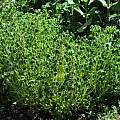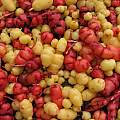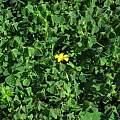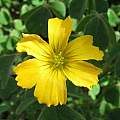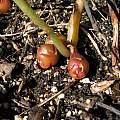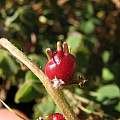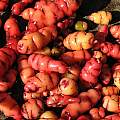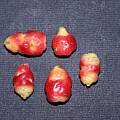Oxalis tuberosa is native from Venezuela to Chile and Argentina, although it has been cultivated in many other South American countries for centuries. Plants have attractive succulent stems and fuzzy leaves with typical yellow flowers. However, the magic of this species lies underground as tubers.
It is known by the following common names: oca, oka, papa oca, ibia, apiha, apiña, apilla, kawi, lamaki, timbo, quiba, papa roja, huisisai, yam, and New Zealand yam. Oca is one of the important crops of the Andes, grown by the natives as a food source for centuries. Peru, Ecuador, Bolivia and New Zealand are the largest producers of this species as a commercial crop. Breeders have created many varieties. Colours of the tubers vary by cultivar: dark purple, magenta, red, amber, yellow, green, brown, and variegated. It is tasty and nutritious. When eaten raw, they are crunchy, mild, pleasing and taste of apple (due to the mild acidic flavour) and are excellent in a salad. They can also be prepared in other ways: boiled, baked, roasted or fried. In the Andes they are often incorporated into stews and soups, or sweetened as a dessert. Oca can also be made into a nice marmalade. In Mexico, oca is eaten raw with salt, lemon and hot peppers.
Oca is easiest to grow in climates that have cool nights in the summer and very late (or no) frosts in winter, making it excellent for growing in milder parts of California and Oregon (Sunset Zones: 6-9, 16-24). It is a highly productive crop and is not susceptible to as many pests and diseases as potatoes are. It should be provided full sun and well-drained fertile soil with a pH range of 5.3-7.8. Oca forms tubers only at a day-length under ~12 hours and needs a long growing season. In the Northern Hemisphere tuber formation begins after the fall equinox (Sept. 21st) and the tubers require 1-3 subsequent frost-free months for full development. This means that oca won't form tubers in equatorial latitudes where the change in day-length is not sufficient. Since the time of year that oca forms tubers is at roughly the same time of year that early frosts begin to hit in autumn of temperate climates, oca will need clear overhead protection from frost in more chilly climates (Pacific Northwest, Central and East US). If there isn't protection from autumn frosts, oca will fail to form new tubers. Another trick to get the plants to form tubers in early autumn (and thus avoid late autumn frosts) is to cover the plants with shade cloth to simulate diminishing day length. The tubers themselves are very cold-hardy, tolerating soil temperatures down to 20 °F (-6.6 °C) with proper protection. Propagation of oca is similar to potatoes, planting each tuber about 12' (30 cm) apart and 2-3' (5-8 cm) deep. Oca can also be grown in large containers such as wine barrels cut in half. It requires moderate summer rainfall between 21-87.7" (550-2100 mm) per year or it can be provided with supplemental watering if needed. In early fall, good soil should be piled onto the stems for higher tuber yield (just like how one grows potatoes).
The plant is a summer grower. In coastal California, the tubers can be planted in February (or when the shoots start to protrude from the tubers) but they won't come up until late April-May when the temperature has warmed up sufficiently. The plants are slow to start, but eventually by mid-summer they are large and by autumn will produce yellow flowers. The above portion of the plants are typically killed of by frost and thus signaling time for harvest. This typically occurs in January. Tubers can be kept potted outside protected from hard frost, and even with lots of rain the tubers don't seem to have issues. Once harvested, allow the tubers to "mature" in the sun for a day or two. This process intensifies the red colors due to the reaction of anthocyanins with sunlight. The sunning process also causes oxalic acid that is concentrated mainly in the skin to break down, resulting in a lot sweeter tubers. Store the tubers in a protected medium so that it does not desiccate. The plant can also produce aerial tubers along the stem. Plants that do not get full sun do not produce a lot of large tubers. Periodic fertilizing also seems to help.
The photos below were taken by Nhu Nguyen showing a yellow form (from New Zealand). Note that the stems are not red like the ones in the red form. Photo 3 shows a mixed batch of red and yellow tubers.
The photos below taken by Nhu Nguyen show a red form. Note that the stems and petioles are colored.
Photo 2 shows an aerial tuber. Photos by Nhu Nguyen.
The photos below by Nhu Nguyen show different cultivars. Photo 1 shows the clone called 'OE Orange' and photo 2 shows the clone called 'Rebo'.
